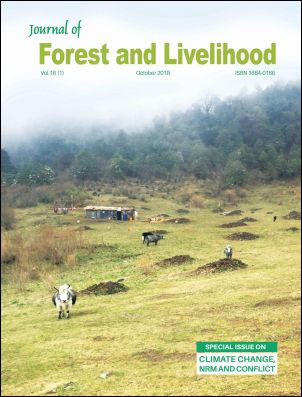Pastoralism in Crisis: Mounting Challenges in Herding System in High Altitude Region of Nepal
DOI:
https://doi.org/10.3126/jfl.v16i1.22882Keywords:
Community forestry, conflict, climate change, livelihood, Mountain pastoralismAbstract
This paper discusses on the mounting livelihoods challenges of high altitude region of Nepal driven largely by the growing conflict between pastoralists and community forestry (CF), and offers alternative pathways. The paper is based on a three-year action research using adaptive learning as an approach to understanding conflicts between the herders and CF members and other challenges around high altitude herding. The paper also brings the case of Suspa- Kshamawati Kalinchowk region with pragmatic issues and concerns that need urgent action. In addition, we analyse information on CF and other pastureland, institutional arrangements of CFUG, analysis of herders’ livelihoods and review of policy process and relevant literature. The research shows that high altitude herding system has been facing several challenges with the conflict between the CF and herders as the main challenge. The conflict with CF has posed extreme threats to the existence of herding system in the region. Similarly, challenges like declining availability and access to quality pasture and hardship, and changing social values has contributed to decreasing herding number in recent years and has also put the unique transhumance livelihood activities in crisis. Finally, implications to policy and practice of CF and overall environmental governance are identified.
Downloads
References
in High Altitude Areas in Nepal: A Review
and Synthesis of Information. Livelihoods
and Forestry Programme (LFP), Kathmandu,
Nepal.
Acharya, D. and Baral, N.R. 2017. Neglected
High Altitude Rangelands of Nepal: Need for
Reform. Journal of Forest and Livelihoods, 15(1):
103-119.
Banjade, M.R. and Paudel, N.S. 2008. Mobile
Pastoralism in Crisis: Challenges, Conflicts and
Status of Pasture Tenure in Nepal Mountains.
Journal of Forest and Livelihoods, 7(1): 49-57.
Baral, N.R., Acharya, D.P., and Rana, C.J.
2012. Study on Drivers of Deforestation and
Degradation of Forests in High Mountain
Regions of Nepal. REDD-Forestry and
Climate Change Cell, Ministry of Forests and
Soil Conservation, Government of Nepal,
Kathmandu, Nepal.
Baral, N.R. 2001. Study of Exclusion and Equity
in the High Altitude Region as an Implication
of Community Forestry: Experiences from
Sindhupalchok and Dolkha
Baral, N.R. 2015. Documentation and
Assessing Customary Practices of Managing
Forest Resources at Local Level. REDD
Implementation Centre, Ministry of Forests
and Soil Conservation, Government of Nepal,
Kathmandu, Nepal.
Barsila, S.R. 2008. Livestock and Rangeland in
Selective High Altitude Districts of Nepal: A
Review. Initiative for Social Transformation
Nepal, Kathmandu, Nepal.
Bauer, J.J. 1989. Grassland Ecology of the
Himalayan Region: Survey Manual. Rome:
Food and Agriculture Organization.
Bauer, K.K. 2004. High Frontiers: Dolpo and the
Changing World of Himalayan Pastoralists.
New York: Columbia University Press.
Brower, B. 1990. Range Conservation and Sherpa
Livestock Management in Khumbu, Nepal.
Mountain Research and Development, 10(1): 34-
42.
DFRS. 2015. State of Nepal’s Forests. Department
of Forest Research and Survey (DFRS),
Government of Nepal, Kathmandu, Nepal.
Dhakal, B., Bigsby, H. and Cullen, R. 2005.
Impacts of Community Forestry Development
on Livestocks Based Livelihood In Nepal.
Journal of Forest and Livelihood, 4 (2).
Dong, S., Wen, L., Liu, S., Zhang, X., Lassoie,
J.P., Yi, S., Li, X., Li, J. and Li, Y. 2011.
Vulnerability of Worldwide Pastoralism
to Global Changes and Interdisciplinary
Strategies for Sustainable Pastoralism. Ecology
and Society, 16: 2-10.
Fu, Y., Grumbine, R., Wilkes, A., Wang, Y., Xu,
J.C. and Yang, Y.P. 2012. Climate Change
Adaptation among Tibetan Pastoralists:
Challenges in Enhancing Local Adaptation
through Policy Support. Environmental
Management, 50(4): 607-621.
Gerrard, R., Kohler, T., Price, F., Byers, A.C.,
Sherpa, A.R. and Maharjan, G.R. 2016. Land
Use and Land Cover Change in Sagarmatha
National Park: A World Heritage Site in
the Himalayan of Eastern Nepal. Mountain
Research and Development, 36(3): 299-310.
Ghimire, S.K. and Parajuli, D.B. 2001.
Indigenous Knowledge and Practice of Pasture
Management among the Pugmo People of Shey
Phoksundo National Park, Dolpo. The Wildlife
Magazine, 3(1): 7-14.
GoN. 2010. National Adaptation Program of
Action, 2010. Ministry of Environment,
Science and Technology, Government of
Nepal, Kathmandu, Nepal.
GoN. 2012. Rangeland Policy 2012. Government of
Nepal, Kathmandu, Nepal.
GoN. 2014. Annual Report 2013/14. District
Livestock Development Office, Government
of Nepal, Dolakha, Nepal.
GoN/MoFSC. 2014. Nepal Biodiversity Strategy
and Action Plan 2014-2020. Government
of Nepal/ Ministry of Forests and Soil
Conservation, Kathmandu, Nepal.
GoN/MoLD. 2017. Livestock Statisticts of Nepal.
Government of Nepal/Ministry of Livestock
Development, Kathmandu, Nepal.
Hinrichsen, D., Lucas, P., Coburn, B. and Upreti,
B.N. 1983. Saving Sagarmatha. Ambio, 12(3-4):
203-205.
Jackson, W.J., Tamrakar, R., Hunt, S. and
Shepherd, K.R. 1998. A Comparative Study
of Land Use in the Two Middle Hills Districts
of Nepal. Mountain Research and Development,
18(3): 193-212.
Joshi, D.D. 1994. Yak Production in Nepal.
Proceedings of the First International Congress
On Yak. Journal of Gansu Agricultural
University (Special Issue, June 1994). Pp.
105-112. [Reprinted in Asian Livestock (Fao
Bangkok), 1994, Xix (10), 132136.
Mcveigh. C. 2004. Himalayan Herding is Alive
and Well: The Economics of Pastoralism in the
Langtang Valley. Nomadic Peoples, 8(2): 107-
124.
Ning W., Rawat, S.G. and Sharma, E. 2013.
High-Altitude Ecosystem Interfaces in the
Hindu Kush Himalayan Region. International
Center for Integrated Mountain Development,
Kathmandu, Nepal.
Pandey M.R. and Chhetri, M. 2005. Nomads
and Pastoralism: Linkage with Biodiversity
Conservation in Upper Mustang, Nepal. Our
Nature 3:42-49.
Parajuli, D.P., Paudel, L.N. and Gyawali, R.R.
2013. Changes in Pastoral Production Systems
in High-Altitude Village-Rangeland Interfaces
in Nepal. Special Issue, 30, International
Center for Integrated Mountain Development,
Kathmandu, Nepal.
Shrestha, B.S., Joshi, B.R. and Joshi, H.D. 2006.
Migratory Small Ruminants: Their Potential
and Economic Contribution in the High Hills
and Mountains of Nepal. In: Proceedings of
the 6th National Workshop on Livestock and
Fisheries, 1-2 July 2004, Nepal Agricultural
Research Council, Lalitpur, Nepal.
Siktel, K.P. 1995. Fug Conflicts in Dolkha and
Ramechap. Banko Jankari, 5(3): 116-119.
Downloads
Published
How to Cite
Issue
Section
License
CC-BY-NC: This license allows reusers to distribute, remix, adapt, and build upon the material in any medium or format for noncommercial purposes only, and only so long as attribution is given to the creator.





